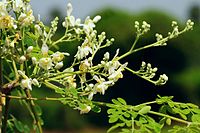
Photo from wikipedia
The roots, leaves, and seeds of Lepidium sativum L., popularly known as Garden cress in different regions, have high economic importance; although, the crop is particularly cultivated for the seeds.… Click to show full abstract
The roots, leaves, and seeds of Lepidium sativum L., popularly known as Garden cress in different regions, have high economic importance; although, the crop is particularly cultivated for the seeds. In traditional medicine, this plant has been reported to possess various biological activities. This review is aimed at providing updated and critical scientific information about the traditional, nutritional, phytochemical, and biological activities of L. sativum. In addition, the geographic distribution is also reviewed. The comprehensive literature search was carried out with the help of different search engines PubMed, Web of Science, and Science Direct. This review highlighted the importance of L. sativum as an edible herb that possesses a wide range of therapeutic properties along with high nutritional values. Preclinical studies (in vitro and in vivo) displayed anticancer, hepatoprotective, antidiabetic, hypoglycemic, antioxidant, antimicrobial, gastrointestinal, and fracture/bone healing activities of L. sativum and support the clinical importance of plant-derived bioactive compounds for the treatment of different diseases. Screening of literature revealed that L. sativum species and their bioactive compounds may be a significant source for new drug compounds and also could be used against malnutrition. Further clinical trials are needed to effectively assess the actual potential of the species and its bioactive compounds.
Journal Title: Oxidative Medicine and Cellular Longevity
Year Published: 2022
Link to full text (if available)
Share on Social Media: Sign Up to like & get
recommendations!